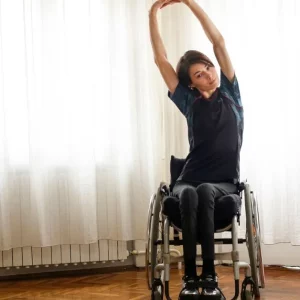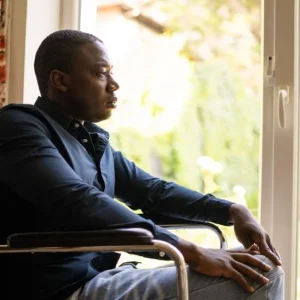A potential secondary effect of spinal cord injury is the development of scoliosis. Scoliosis describes a condition in which the spine develops a sideways curvature. While it is most common during adolescence, scoliosis can also develop in adulthood, especially when a spinal cord injury is involved.
To help you understand the relationship between a spinal cord injury and scoliosis, this article will discuss:
- Can a spinal cord injury cause scoliosis?
- How scoliosis after spinal cord injury can affect your quality of life
- How to manage scoliosis after SCI
Can a Spinal Cord Injury Cause Scoliosis?
A spinal cord injury can paralyze the muscles that make up your trunk, which can make it difficult to maintain sitting balance and posture, especially when unsupported. When posture is consistently compromised, it can contribute to the development of neuromuscular scoliosis.
Unlike idiopathic scoliosis (which is the most common form of spinal deformity), neuromuscular scoliosis is the result of damage to the central nervous system (the brain and/or spinal cord). Depending on the area of nerve damage in the CNS, motor control may be affected, resulting in a lack of stability in the muscles surrounding the spine and thereby increasing the risk of developing neuromuscular scoliosis. Following a spinal cord injury, individuals may lose motor control and/or sensation, which can lead to difficulties maintaining an upright position.
Additionally, some individuals with spinal cord injuries experience involuntary, prolonged muscle contractions called spasticity that can pull the body into abnormal postures and further contribute to the development of scoliosis.
Because individuals with neurological conditions tend to have higher rates of spinal deformity, it’s essential to understand the risks associated with unmanaged scoliosis and how to effectively manage posture. The following section will discuss how neuromuscular scoliosis secondary to spinal cord injury can affect your quality of life.
How Scoliosis After Spinal Cord Injury Can Affect Your Quality of Life

Developing scoliosis as a result of spinal cord injury can affect your quality of life in many ways.
A sideways curvature of the spine completely shifts your center of gravity and makes it difficult to maintain balance. As a result, individuals may experience a variety of physical complications, including:
- Difficulties walking, sitting, or standing independently
- Frequent falls
- Chronic pain due to increased pressure on the lower back and hips
- Development of pressure ulcers
- Breathing difficulties
These complications can significantly affect one’s functional independence and contribute to challenges performing activities of daily living such as getting out of bed, performing wheelchair transfers, and getting dressed. As a result, individuals may become more dependent on a caregiver to care for themselves.
Additionally, the development of scoliosis can also impair an individual’s psychological wellbeing. Potential psychological effects of scoliosis secondary to spinal cord injury include:
- Poor body image
- Social isolation
- Low self-esteem
- Depression
Now that you understand the physical and psychological risks associated with scoliosis after SCI, the next section will discuss management interventions.
How to Manage Scoliosis After Spinal Cord Injury

Although scoliosis can gradually progress and cause further complications, it is generally not considered a medical emergency. By proactively seeking management interventions when early signs of compromised posture arise, individuals with spinal cord injuries can minimize the progression of an abnormal spinal curvature and maximize their quality of life.
Below, we’ll discuss several management interventions for scoliosis after spinal cord injury.
Wheelchair Modifications
Generally, individuals with more severe, higher-level SCIs spend a lot of time in their wheelchairs because it is their primary source of mobility. Adding wheelchair modifications such as a back or seat mold can help position the torso in a more functional orientation. This makes it easier to maintain sitting balance without compromising posture.
Braces
A spinal brace is a wearable device that helps promote musculoskeletal alignment.
There are a variety of spinal braces available. Some wrap around your entire trunk, while others only wrap around a certain area to provide extra structural support.
It’s important to understand that wearing a brace or using a wheelchair mold will not reverse the effects of scoliosis. However, it can help:
- support your trunk so that it is easier to maintain sitting balance
- gently stretch spastic muscles and prevent muscles from further tightening
- delay the need for surgery
Exercise and Physical Therapy
Participating in physical therapy after spinal cord injury is essential to identify functional weaknesses and work towards rehabilitating them through targeted exercises.
Core exercises will help improve sitting balance by strengthening and stimulating the neural connections between the trunk and central nervous system.
The more you practice consciously correcting your sitting posture, the more comfortable it will feel. This occurs because the central nervous system has neuroplasticity (the ability to rewire itself) and adapts to repetitive stimulation.
Surgery
Spinal fusion surgery, when used as a treatment for scoliosis, is typically only recommended when the spinal curve starts to become severe (around 50 degrees). It involves using bone grafts, screws, and rods to fuse the vertebrae together. Although surgery likely will not completely straighten the spinal curvature, it will prevent the curve from progressing.
Spinal Cord Injury and Scoliosis: Key Points

Scoliosis can develop after a spinal cord injury due to nerve damage that results in the loss of control over the muscles that make up your core. These muscles are essential for maintaining balance. Without control over them, individuals will struggle to maintain an upright position and start leaning to the side.
Additionally, involuntary muscle contractions known as spasticity can result in asymmetrical muscle tension throughout the body and further contribute to the development of scoliosis.
Scoliosis after spinal cord injury can be effectively managed through bracing, physical therapy, and surgery. However, the ability to regain control over the core muscles will primarily depend on the severity and level of your SCI and how aggressively you pursue rehabilitation.
We hope this article motivates you to take the precautions necessary to avoid compromised posture and maximize your mobility.











